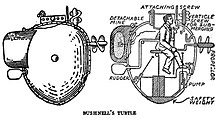Upon opening this kit I was quite surprised and a little disappointed as to how small the kit was.
That and the small number of parts, so what to do.
First I completely scratched out a new top made totally out of brass. Then I added a barrel to replace the simple box that came with the kit. I then added the chain and rings.
The display base was made from wooden ship spare parts I had.
It's a very small model but pretty.
From Wikipedia"
Turtle (also called American Turtle) was the world's first submersible vessel with a documented record of use in combat. It was built in 1775 by American David Bushnell as a means of attaching explosive charges to ships in a harbor, for use against British Royal Navy vessels occupying North American harbors during the American Revolutionary War. Connecticut Governor Jonathan Trumbull recommended the invention to George Washington, who provided funds and support for the development and testing of the machine.
Several attempts were made using Turtle to affix explosives to the undersides of British warships in New York Harbor in 1776. All failed, and her transport ship was sunk later that year by the British with the submarine aboard. Bushnell claimed eventually to have recovered the machine, but its final fate is unknown. Modern replicas of Turtle have been constructed and are on display in the Connecticut River Museum, the U.S. Navy's Submarine Force Library and Museum, the Royal Navy Submarine Museum, and the Oceanographic Museum (Monaco).
The American inventor David Bushnell conceived of the idea of a submersible for use in lifting the British naval blockade during the American War of Independence. Bushnell may have begun studying underwater explosions while at Yale College. By early 1775, he had created a reliable method for detonating underwater explosives, a clockwork connected to a musket firing mechanism, probably a flintlock, adapted for the purpose.
After the Battles of Lexington and Concord in April 1775, Bushnell began work near Old Saybrook on a small, individually-manned submersible designed to attach an explosive charge to the hull of an enemy ship, which, he wrote Benjamin Franklin, would be, “Constructed with Great Simplicity and upon Principles of Natural Philosophy.”
Little is known about the origin, inspiration, and influences for Bushnell’s invention. It seems clear Bushnell knew of the work of the Dutch inventor Cornelius Drebbel.
According to Dr. Benjamin Gale, a doctor who taught at Yale, the many brass and mechanical (moving) parts of the submarine were built by the New Haven clock-maker, engraver, silversmith, brass manufacturer and inventor Isaac Doolittle, whose shop was just a half block from Yale. Though Bushnell is given the overall design credit for the Turtle by Gale and others, Doolittle was well known as an "ingenious mechanic" (i.e. an engineer), engraver, and metalworker. He had both designed and manufactured complicated brass-wheel hall-clocks, a mahogany printing-press in 1769 (the first made in America, after Doolittle successfully duplicated the iron screw), brass compasses, and surveying instruments. He also founded and owned a brass foundry where he cast bells. At the start of the American Revolution, the wealthy and patriotic Doolittle built a gunpowder mill with two partners in New Haven to support the war, and was sent by the Connecticut government to prospect for lead.
Though the design of the Turtle was necessarily shrouded in secrecy, based on his mechanical engineering expertise and previous experience in design and manufacturing, it seems Doolittle designed and crafted (and probably funded) the brass and the moving parts of the Turtle, including the propulsion system, the navigation instruments, the brass foot operated water-ballast and forcing pumps, the depth gauge and compass, the brass crown hatch, the clockwork detonator for the mine, and the hand operated propeller crank and foot-driven treadle with flywheel. According to a letter from Benjamin Gale to Benjamin Franklin, Doolittle also designed the mine attachment mechanism, "those Parts which Conveys the Powder, and secures the same to the Bottom of the Ship". The most historically important innovation in the Turtle was the propeller, as it was the first known use of one in a watercraft: it was described as an "oar for rowing forward or backward", with "no precedent" design. As it was probably brass, it was thus likely forged if not designed by Doolittle. Doolittle also likely provided the scarce commodities of gunpowder and lead ballast as well. The wealthy Doolittle, nearly 20 years older than the Yale student Bushnell, was a founder and long time Warden of Trinity Episcopal Church on the Green,, and was in charge of New Haven's port inspection and beacon-alarm systems – suggesting that Doolittle provided much of the political and financial leadership in building the Turtle as well as its brass and moving parts.
In making the hull, Bushnell enlisted the services of several skilled artisans, including his brother the farmer Ezra Bushnell and ship's carpenter Phineas Pratt, both, like David Bushnell, from Saybrook.. The hull was “constructed of oak, somewhat like a barrel and bound by heavy wrought-iron hoops.” The shape of the hull, Gale informed Silas Deane, “has the nearest resemblance to the two upper shells of a Tortoise joined together.”
This 19th-century diagram shows the side views of Turtle. It
incorrectly depicts the propeller as a screw blade; as seen in the
replica photographed above and reported by Sergeant Lee, it was a paddle
propeller blade.
A diagram showing the front and rear of Turtle
Bushnell's basic design included some elements present in earlier experimental submersibles. The method of raising and lowering the vessel was similar to that developed by Nathaniel Simons in 1729, and the gaskets used to make watertight connections around the connections between the internal and external controls also may have come from Simons, who constructed a submersible based on a 17th-century Italian design by Giovanni Alfonso Borelli.



























